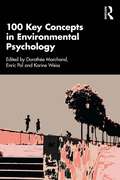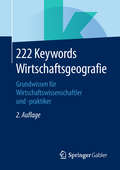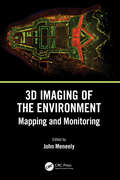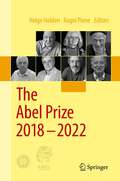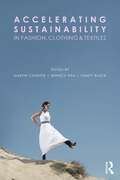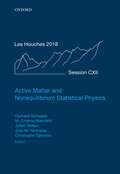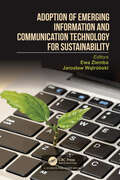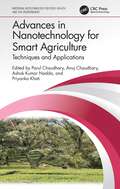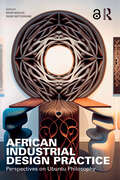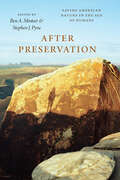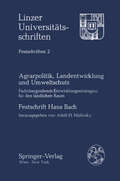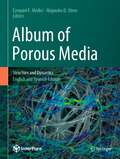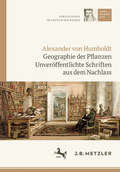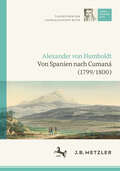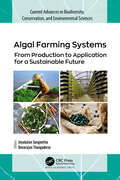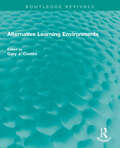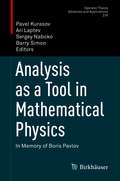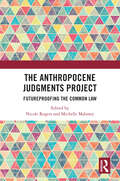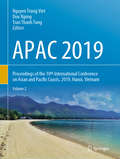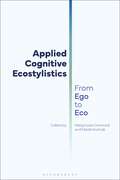- Table View
- List View
100 Key Concepts in Environmental Psychology
This accessible book defines 100 key concepts, ideas and processes in Environmental Psychology to provide an introductory reference work that brings together research and theory in a bite-size format. With contributions from leading figures within Environmental Psychology, each concept is clearly defined and explained within the context of issues around the environment, sustainability, climate change, nature and architecture. This book considers the involvement of psychological, physiological and social processes to understand the mechanisms that explain and contribute to the evolution of behavior and attitudes that relate to our relationship with the environment. Concepts covered include biodiversity, eco-anxiety, place identity, sustainable behaviour, climate justice and environmental attitudes. By integrating ideas from different disciplinary orientations in the field of Environmental Psychology, this book allows for a better understanding of the processes related to the individual-environment relationship, as well as the applications that they allow for in various fields of intervention. This is essential reading for students and researchers in Environmental Psychology, Sustainability Studies, Architecture and Built Environment Studies and related fields.
222 Keywords Wirtschaftsgeografie: Grundwissen für Wirtschaftswissenschaftler und -praktiker
Von der Arrondierung über Footloose Industry und Isolinien bis zur Zeitdistanzmethode: Die Sprache der Wirtschaftsgeografie ist von zahlreichen Fachtermini und Anglizismen geprägt. Einen ersten schnellen Überblick verschafft das vorliegende Nachschlagewerk. Anhand von 222 übersichtlichen Schlüsselbegriffen werden die Grundkonzepte und -theorien der Wirtschaftsgeografie erläutert. Die Erklärungen sind kompakt und verständlich formuliert und bieten somit Basiswissen für alle, die einen schnellen Einstieg suchen, sich für die Grundlagen der Wirtschaftsgeografie interessieren oder ihre vorhandenen Kenntnisse auffrischen möchten.
3D Imaging of the Environment: Mapping and Monitoring
This is a comprehensive, overarching, interdisciplinary book and a valuable contribution to a unified view of visualisation, imaging, and mapping. It covers a variety of modern techniques, across an array of spatial scales, with examples of how to map, monitor, and visualise the world in which we live. The authors give detailed explanations of the techniques used to map and monitor the built and natural environment and how that data, collected from a wide range of scales and cost options, is translated into an image or visual experience. It is written in a way that successfully reaches technical, professional, and academic readers alike, particularly geographers, architects, geologists, and planners. FEATURES Includes in-depth discussion on 3D image processing and modeling Focuses on the 3D application of remote sensing, including LiDAR and digital photography acquired by UAS and terrestrial techniques Introduces a broad range of data collection techniques and visualisation methods Includes contributions from outstanding experts and interdisciplinary teams involved in earth sciences Presents an open access chapter about the EU-funded CHERISH Project, detailing the development of a toolkit for the 3D documentation and analysis of the combined coastline shared between Ireland and Wales Intended for those with a background in the technology involved with imaging and mapping, the contributions shared in this book introduce readers to new and emerging 3D imaging tools and programs.
The Abel Prize 2018-2022 (The Abel Prize)
The book presents the winners of the Abel Prize in mathematics for the period 2018–2022: - Robert P. Langlands (2018) - Karen K. Uhlenbeck (2019) - Hillel Furstenberg and Gregory Margulis (2020) - Lászlo Lóvász and Avi Wigderson (2021) - Dennis P. Sullivan (2022) The profiles feature autobiographical information as well as a scholarly description of each mathematician’s work. In addition, each profile contains a Curriculum Vitae, a complete bibliography, and the full citation from the prize committee. The book also includes photos from the period 2018–2022 showing many of the additional activities connected with the Abel Prize. This book follows on The Abel Prize: 2003–2007. The First Five Years (Springer, 2010) and The Abel Prize 2008–2012 (Springer, 2014) as well as on The Abel Prize 2013–2017 (Springer, 2019), which profile the previous Abel Prize laureates.
Accelerating Sustainability in Fashion, Clothing and Textiles
The issue of sustainability is characterised as a ‘wicked problem’ in the fashion, clothing and textiles sector and is now coming into increased focus due to growing consumer, business and policy pressures. This in-depth volume presents a comprehensive overview of the challenges and emerging opportunities faced by the sector, and provides strategic solutions as to how the sector can substantially accelerate sustainability. This book collates research and industry best practice to provide a ‘one-stop shop’ exploring the complex and interconnected issues surrounding sustainability in fashion, clothing and textiles. The practical and digestible chapters include innovative examples and perspectives from different regions of the globe, addressing topics from policies to supply chain issues and materials innovation. Five unique case studies of sustainable businesses provide detailed examples of pioneering practice. Edited by three professionals with long-standing knowledge and expertise, the book takes a global perspective with examples that illustrate the scale and breadth of topics and regions in the scope of sustainability. This holistic approach brings together both academic and industry perspectives on the critical areas that require immediate action to move towards a more sustainable fashion, clothing and textile sector. This is an invaluable resource for those working in the industry, policymakers and for those in business or academia with an interest in sustainability in fashion, clothing, textiles and related sectors worldwide. It is also relevant to professionals and students in the areas of sustainability, innovation, supply chains, design and development, consultancy, education and training.
Active Matter and Nonequilibrium Statistical Physics: Lecture Notes of the Les Houches Summer School: Volume 112, September 2018 (Lecture Notes of the Les Houches Summer School #112)
From molecular motors to bacteria, from crawling cells to large animals, active entities are found at all scales in the biological world. Active matter encompasses systems whose individual constituents irreversibly dissipate energy to exert self-propelling forces on their environment. Over the past twenty years, scientists have managed to engineer synthetic active particles in the lab, paving the way towards smart active materials. This book gathers a pedagogical set of lecture notes that cover topics in nonequilibrium statistical mechanics and active matter. These lecture notes stem from the first summer school on Active Matter delivered at the Les Houches school of Physics. The lectures covered four main research directions: collective behaviours in active-matter systems, passive and active colloidal systems, biophysics and active matter, and nonequilibrium statistical physics—from passive to active.
Adoption of Emerging Information and Communication Technology for Sustainability
This book represents an important voice in the discourse on the adoption of emerging ICT for sustainability. It focuses on how emerging ICT acts as a crucial enabler of sustainability, offering new forward-looking approaches to this field. The book explores how emerging ICT adoption drives sustainability efforts in business and public organizations, promoting ecological, economic, social, cultural, and political sustainability. The book's theoretical discussions, conceptual approaches, empirical studies, diverse perspectives, and views make it a valuable and comprehensive reference work. Appealing to both researchers and practitioners, this book provides significant areas for research and practice related to the contribution of emerging ICT adoption to sustainability. It also suggests vital considerations for programming and building sustainable development-driven emerging ICT adoption. Readers will find answers to important contemporary questions, such as: What are the concepts, frameworks, models, and approaches to enhance sustainable development through the adoption of emerging ICT? How does the adoption of emerging ICT influence sustainability? How can emerging ICT be adopted to enhance sustainability? What are the current practices and successful cases of emerging ICT adoption for sustainability? What factors influence emerging ICT adoption to enhance sustainability?
Advances in Crop Production and Climate Change
This book has comprehensive coverage and advances in agriculture for sustainable development and is expected to provide valuable sources for scholars and researchers, as well as serve as a guide book to the farmer’s community and development agencies. The book is organized into 18 chapters, which include advances in production technologies of crops e.g. rice, wheat, barley, maize, pearl millet, pulses and oilseeds; sugarcane; medicinal and aromatic plants; vegetable crops; fodder crops; resource conservation technologies; management of degraded and sodic lands; soil biodiversity; farm mechanization, etc. The text is illustrated with tables, figures and photographs to bring out the significant findings. The book provides cutting-edge scientific knowledge as well as solid background information that are accessible for those who have a strong interest in agricultural research and development and want to learn more on the challenges facing the global agricultural production systems. Note: T&F does not sell or distribute the Hardback in India, Pakistan, Nepal, Bhutan, Bangladesh and Sri Lanka. This title is co-published with New India Publishing Agency.
Advances in Nanotechnology for Smart Agriculture: Techniques and Applications (Microbial Biotechnology for Food, Health, and the Environment)
The yield of major agricultural crops can be severely decreased due to the inappropriate application of commonly used harmful chemicals. Excessive agrochemicals in field application can negatively affect microbial populations and their diversity, which in turn ultimately affects plant growth. Thus, it is necessary to turn toward more eco-friendly approaches which equally protect crops as well as the desirable microbial populations of complex soil systems. Nanoparticles are considered as potential agents for the production and development of sustainable agriculture. Green synthesis of nanoparticles has gained attention as a useful measure to diminish the harmful effects associated with the old methods of nanoparticle synthesis. Advances in Nanotechnology for Smart Agriculture: Techniques and Applications illustrates the science and practical applications of nanoparticles for sustainable agriculture. Features: Examines the role of nanotechnology in agricultural best practices, including sustainable development, precision farming, and long-term soil health
Africa [3 volumes]: An Encyclopedia of Culture and Society [3 volumes]
These volumes offer a one-stop resource for researching the lives, customs, and cultures of Africa's nations and peoples.Unparalleled in its coverage of contemporary customs in all of Africa, this multivolume set is perfect for both high school and public library shelves. The three-volume encyclopedia will provide readers with an overview of contemporary customs and life in North Africa and sub-Saharan Africa through discussions of key concepts and topics that touch everyday life among the nations' peoples. While this encyclopedia places emphasis on the customs and cultural practices of each state, history, politics, and economics are also addressed. Because entries average 14,000 to 15,000 words each, contributors are able to expound more extensively on each country than in similar encyclopedic works with shorter entries. As a result, readers will gain a more complete understanding of what life is like in Africa's 54 nations and territories, and will be better able to draw cross-cultural comparisons based on their reading.
African Industrial Design Practice: Perspectives on Ubuntu Philosophy
The underlying principle of this book is the African philosophy of Ubuntu, which acts as a guide for developing empathic products and services. The book makes the case that empathy is the key to any successful product and service design project because it enables designers to make wise design choices that align with users' demands.Fifteen chapters provide the latest industrial design developments, techniques, and processes explicitly targeting emerging economies. At the outset, it covers the design context and the philosophy of the Ubuntu approach, which places people and communities at the centre of the development agenda. The book covers new product development, design research, design cognition, digital and traditional prototyping, bringing products to the market, establishing a company's brand name, intellectual property rights, traditional knowledge, and the business case for design in Afrika. It concludes with a discussion about the future of design and the skills aspiring designers will need.African Industrial Design Practice: Perspectives on Ubuntu Philosophy will be an essential textbook for undergraduates, postgraduates, instructors, and beginner designers in emerging economies to provide regionally contextualised design processes, illustrated examples, and outcomes.Chapter 2 of this book is freely available as a downloadable Open Access PDF at http://www.taylorfrancis.com under a Creative Commons Attribution-Non Commercial-No Derivatives (CC-BY-NC-ND) 4.0 license.
African Successes, Volume IV: Sustainable Growth (National Bureau of Economic Research Conference Report #4)
Studies of African economic development frequently focus on the daunting challenges the continent faces. From recurrent crises to ethnic conflicts and long-standing corruption, a raft of deep-rooted problems has led many to regard the continent as facing many hurdles to raise living standards. Yet Africa has made considerable progress in the past decade, with a GDP growth rate exceeding five percent in some regions. The African Successes series looks at recent improvements in living standards and other measures of development in many African countries with an eye toward identifying what shaped them and the extent to which lessons learned are transferable and can guide policy in other nations and at the international level. The fourth volume in the series, African Successes: Sustainable Growth combines informative case studies with careful empirical analysis to consider the prospects for future African growth.
African Virtue Ethics Traditions for Business and Management
African nations are many and diverse, each one of them a multicultural home to philosophies that have enriched human communities over the centuries. Yet, the continent’s wisdom remains largely undocumented. Of particular importance are those insights that could serve as stimuli to the more responsible and sustainable management of the global economy and the earth’s resources. African philosophies about the way to live a flourishing life are predominantly virtue-oriented. However, narratives of African conceptions of virtue are uncommon. This book therefore helps bridge an important gap in literature. Authors writing from South Africa, Ghana, Egypt, Kenya, Mauritius, Côte D’Ivoire and Nigeria share research on indigenous wisdoms on virtue, displaying a marked consensus about the communitarian nature of African virtue ethics traditions and virtues essential for a flourishing life. They also show how indigenous virtue ethics improve corporate practices. This book will be a launchpad for further studies in Afriethics as well as a medium for sharing rich knowledge with the rest of the world. These chapters form a unique record in ethics for researchers, teachers, students and management practitioners of responsible management and African studies.
After Preservation: Saving American Nature in the Age of Humans
From John Muir to David Brower, from the creation of Yellowstone National Park to the Endangered Species Act, environmentalism in America has always had close to its core a preservationist ideal. Generations have been inspired by its ethos—to encircle nature with our protection, to keep it apart, pristine, walled against the march of human development. But we have to face the facts. Accelerating climate change, rapid urbanization, agricultural and industrial devastation, metastasizing fire regimes, and other quickening anthropogenic forces all attest to the same truth: the earth is now spinning through the age of humans. After Preservation takes stock of the ways we have tried to both preserve and exploit nature to ask a direct but profound question: what is the role of preservationism in an era of seemingly unstoppable human development, in what some have called the Anthropocene? Ben A. Minteer and Stephen J. Pyne bring together a stunning consortium of voices comprised of renowned scientists, historians, philosophers, environmental writers, activists, policy makers, and land managers to negotiate the incredible challenges that environmentalism faces. Some call for a new, post-preservationist model, one that is far more pragmatic, interventionist, and human-centered. Others push forcefully back, arguing for a more chastened and restrained vision of human action on the earth. Some try to establish a middle ground, while others ruminate more deeply on the meaning and value of wilderness. Some write on species lost, others on species saved, and yet others discuss the enduring practical challenges of managing our land, water, and air. From spirited optimism to careful prudence to critical skepticism, the resulting range of approaches offers an inspiring contribution to the landscape of modern environmentalism, one driven by serious, sustained engagements with the critical problems we must solve if we—and the wild garden we may now keep—are going to survive the era we have ushered in. Contributors include: Chelsea K. Batavia, F. Stuart (Terry) Chapin III, Norman L. Christensen, Jamie Rappaport Clark, William Wallace Covington, Erle C. Ellis, Mark Fiege, Dave Foreman, Harry W. Greene, Emma Marris, Michelle Marvier, Bill McKibben, J. R. McNeill, Curt Meine, Ben A. Minteer, Michael Paul Nelson, Bryan Norton, Stephen J. Pyne, Andrew C. Revkin, Holmes Rolston III, Amy Seidl, Jack Ward Thomas, Diane J. Vosick, John A. Vucetich, Hazel Wong, and Donald Worster.
Agrarpolitik, Landentwicklung und Umweltschutz: Fachübergreifende Entwicklungsstrategien für den ländlichen Raum Festschrift Hans Bach zum 70. Geburtstag dargebracht von Freunden, Kollegen und Schülern (Linzer Universitätsschriften #2)
Dem Agrar- und Gesellschaftswissenschafter Hans Bach anlCiB lich seiner Emeritierung eine Festschrift zu widmen, war seinen Freunden und Schiilem gleichermaBen Anliegen und Verpflich tung. Anliegen, um Hans Bach ihre Verbundenheit zu doku mentieren; Verpflichtung, einen Wissenschafter zu ehren, der jahrzehntelang mutig Auffassungen vertrat, die sich gerade in allerjiingster Zeit unter dem Eindruck einer sich bedrohlich ver stCirkenden Umweltkrise als weise vorausschauend herauszu stellen beginnen. Als Herausgeber darf ich allen, die zum Gelingen dieses Sammel bandes beigetragen haben, sehr herzlich danken. Mein beson derer Dank gilt den A utoren der einzelnen BeitrCige, den Mitarbei tern der Abteilung Agrarpolitik, Landentwicklung und Umwelt schutz am Institut iiir Gesellschaftspolitik der Johannes Kepler UniversitCit Linz sowie Herm o. Univ. Prof. Dr. Richard Holzham mer, der sich um die Aufnahme der Festschrift in die Linzer Uni versitCitsschrifterueihe bemiihte. Ganz besonders hervorheben mochte ich jene Institutionen, die durch ForderungsbeitrCige die Drucklegung der Festschrift ermoglichten. Der Herausgeber Linz, im MCirz 1982 Inhaltsverzeichnis EINLEITUNG . . . . . . . . . . . . . . . . . . . . . . . . 11 1. A bschnitt DIE GANZHEITLICHE SCHAUWEISE AM BEISPIEL GEISTES WISSENSCHAFfLICHER DISZIPLINEN . . . . . . . . . . . 11 Walter Heinrich: Mensch und Mutter Erde. Utopische Anmerkungen zum geistigen Testament von Arnold J. Toynbee . . . . . . . . 19 J. Hanns Pichler: U oIntegrierte oder ganzheitliche Ui. ndliche Entwicklung als Strukturfrage einer entsprechungsgerechten Weltlandwi- schaft . . . . . . . . . . . . . . . . . . . . . . . . . . . 31 Evelyn Grobl: Normative Voraussetzungen politischer Praxis . . . . . . . 53 2. AbschnittAGRARGESCHICHTE UND AGRARSOZIOLOGIE ALS UNENTBEHRLICHE INFORMA TIONSQUELLEN FUR EINE INTEGRATIVE BETRACHTUNG VON AGRARWESEN UND LANDLICHEM RAUM . . . . . . . . . . . . . . . . . . . 69 Albert Hauser: Bauerliche Leitideen im Wandel der Geschichte . . . . . . 11 Ulrich Planck: Der landwirtschaftliche Familienbetrieb als soziales System. 91 9 3.
Album of Porous Media: Structure and Dynamics
Graphical depictions of abstract concepts have played a major role in the formulation and communication of ideas since prehistoric times. The invention of photography in the nineteenth century and more recent advances in visualization techniques have catalyzed an enormous wealth of insights into every field of science and engineering by extending our senses far beyond our natural sensorial capabilities. The field of porous media has also benefited enormously from these developments in visualization techniques. Indeed, improvements in these techniques have led to the better morphological characterization of porous media and an enhanced understanding of the assorted physical processes, such as mass transport, capillarity, swelling, and fracturing, that can occur at the pore level. These observations, in turn, have led to superior usage practices for existing porous materials and the design of new products with porous media. Therefore, this bilingual English-Spanish album is aimed at providing a collection of state‐of‐the‐art visualizations of the diverse aspects of porous media that will serve as a reference in education and research. To cover all these aspects properly, the album is organized into seven thematic parts. Each part includes a collection of chapters with images accompanied by a brief English-Spanish description of the novelty of the observation, the visualization technique used, and the phenomenological insights gained. Las representaciones gráficas de conceptos abstractos han jugado un papel importante en la formulación y comunicación de ideas desde tiempos prehistóricos. La invención de la fotografía en el siglo XIX y los avances más recientes en las técnicas de visualización han catalizado una enorme riqueza de conocimientos en todos los campos de la ciencia y la ingeniería al extender nuestros sentidos mucho más allá de nuestras capacidades sensoriales naturales. El campo de los medios porosos también se ha beneficiado enormemente de estos avances en las técnicas de visualización. De hecho, las mejoras en estas técnicas han llevado a una mejor caracterización morfológica de los medios porosos y una mejor comprensión de los diversos procesos físicos, como el transporte de masa, la capilaridad, la hinchazón y la fractura, que pueden ocurrir a nivel de poro. Estas observaciones, a su vez, han llevado a mejores prácticas de uso para los materiales porosos existentes y al diseño de nuevos productos con medios porosos. Por lo tanto, este álbum bilingüe inglés y español tiene como objetivo proporcionar una colección de visualizaciones del estado del arte de los diversos aspectos de los medios porosos que servirán como referencia en la educación y la investigación. Para cubrir adecuadamente todos estos aspectos, el álbum está organizado en siete partes temáticas. Cada parte incluye una colección de capítulos con imágenes acompañadas de una breve descripción en inglés y español de la originalidad de la observación, la técnica de visualización utilizada y los conocimientos fenomenológicos obtenidos.
Alexander von Humboldt: Unveröffentlichte Schriften aus dem Nachlass (edition humboldt print #1)
Der Band dokumentiert ein Lebensprojekt: Für Alexander von Humboldt war die Geographie der Pflanzen empirisches Forschungsprogramm und ästhetische Anschauungswissenschaft zugleich. Seine in den amerikanischen Tropen gewonnenen biogeographischen Erkenntnisse verstand er als Grundlage einer Wissenschaft der gesamten Erde. Zahlreiche nun erstmals ediert vorliegende Manuskripte, Notizen und Briefe veranschaulichen Humboldts jahrzehntelange Arbeit an diesem Vorhaben. Sie dokumentieren Humboldts Lektüre- und Schreibpraktiken und zeigen wie er weltweit Daten sammelte sowie Forschungen und Gelehrte vernetzte. Wissenschaftshistorische Beiträge begleiten die Edition. Sie gehen Ursprüngen und Kontexten der Humboldt'schen Biogeographie nach und fragen nach weniger bekannten Vorläufern, Zeitgenossen und Kritikern.
Alexander von Humboldt-Handbuch: Leben – Werk – Wirkung | Sonderausgabe
Alexander von Humboldt ist seit dem Ausgang des 20. Jahrhunderts in den unterschiedlichsten Wissensbereichen und Wissenschaftsfeldern zu einer bedeutenden Figur im öffentlichen Diskurs geworden. Das Handbuch macht das gewaltige Oeuvre Humboldts zugänglich und beschreibt Wege und Wirkungen dieses herausragenden Forschers, Gelehrten und Schriftstellers. Ausgehend von der Einsicht in die transdisziplinäre Ausrichtung der Humboldtschen Wissenschaft rekonstruiert es Verbindungen und Wechselwirkungen der unterschiedlichen Betätigungsfelder dieses Vordenkers einer vernetzten Welt. Im Werkteil werden nicht nur die großen Buchpublikationen, sondern auch die unselbständigen Schriften, die umfangreiche Korrespondenz und der Nachlass behandelt. Humboldts wissenschaftliche Aktivitäten werden aus unterschiedlichen Blickwinkeln, von der Wissenschaftsgeschichte und den Naturwissenschaften bis hin zu Geschichts- und Sprachwissenschaft beleuchtet. Auch seine Tätigkeitsfelder in den Bereichen Politik und Diplomatie oder Kunst und Ästhetik werden diskutiert, schließlich die wichtigsten seiner Beziehungen zu Wissenschaftlern und Literaten.
Alexander von Humboldt: Tagebücher der Amerikanischen Reise: Von Spanien nach Cumaná (edition humboldt print #1)
Der erste Tagebuchband der amerikanischen Reise Alexander von Humboldts gibt Einblicke in die Überfahrt von Europa nach Amerika, den Aufenthalt auf Teneriffa und in das Leben und Arbeiten in Cumaná. In seinem Tagebuch beschreibt Humboldt, wie Klima und Vegetation die Kulturgeschichte des Menschen prägen, und bringt seinen Abscheu gegenüber der Sklaverei zum Ausdruck. Sein Interesse gilt ebenso der tropischen Pflanzen- und Tierwelt wie der Lebensweise der indigenen Bevölkerung. Im Herbst 1799 wird er zudem Zeuge einer Sonnenfinsternis, eines Erdbebens und eines beeindruckenden Meteorschauers. Besonders zu faszinieren vermag sein beständiges Ringen um eine Optimierung der Messmethoden. Sein Ziel ist die Kartierung eines noch weitgehend unerschlossenen Kontinents, und er weiß, dass die enormen Anstrengungen, die er und sein Forschungspartner Aimé Bonpland auf sich nehmen, nur dann gerechtfertigt wären, wenn die erhobenen Daten valide sind. – Der durchgängig kommentierte Text ist in neun Kapitel unterteilt, denen jeweils kleine Einführungen vorangestellt sind.
Algal Farming Systems: From Production to Application for a Sustainable Future (Current Advances in Biodiversity, Conservation, and Environmental Sciences)
The farming and cultivation of algae can provide sustainable solutions for issues like food security-related problems, costly health-related products, sustainable fuels, and more. However, the use of algae is currently restricted to high-value, low-volume markets, mainly due to the high investment and production costs involved. In recent years, algaculture for food and fuel purposes has begun a transition from R&D and pilot-scale operations to commercial-scale systems. This new book presents the latest technological innovations in algae production, market status, and prospects for algal applications.The book provides an informative overview of different perspectives on the commercial production of algae-based food, health, and high-value cosmeceutical products, providing an institutional framework to support and promote the development and commercialization of algal farming. The book discusses phycotechnology and highlights the current trends and future scope of algal technology. It also presents new information on algal culture conditions and cultivation strategies, including a look at geographic position and local climate as key factors in the implementation of microalgae-based processes. Algal production, marketing strategies, and their commercialization are discussed, as are the industrial applications of algae, focusing mainly on nutraceutical, pharmaceutical, and cosmeceutical applications of microalgae and macroalgae.
Alternative Learning Environments (Routledge Revivals)
Originally published in 1974, this volume presents viable alternatives to traditional attitudes and practices in environmental design and education. It contains 29 selections that reflect the thought and actions of leaders from many diverse disciplines and professions. Architects, landscape architects, urban planners, teachers and administrators, psychologists and social theorists address themselves to controversial and important issues facing our post-industrial society. The range of subjects explored in the volume is far-reaching: • Environmental education in which the art of planning and designing itself becomes the curriculum • Advocacy planning and community participation in bo9th educational and design decision making • Alternative educational institutions, ranging from community-centered schools and mobile schools to non-school learning networks that distribute the learning activity throughout the fabric of the city and the lifetime of the learner. • New developments in systematic design methods and evaluation research that promise to make the design process more public and responsive to the user-client.
Analysis as a Tool in Mathematical Physics: In Memory of Boris Pavlov (Operator Theory: Advances and Applications #276)
Boris Pavlov (1936-2016), to whom this volume is dedicated, was a prominent specialist in analysis, operator theory, and mathematical physics. As one of the most influential members of the St. Petersburg Mathematical School, he was one of the founders of the Leningrad School of Non-self-adjoint Operators. This volume collects research papers originating from two conferences that were organized in memory of Boris Pavlov: “Spectral Theory and Applications”, held in Stockholm, Sweden, in March 2016, and “Operator Theory, Analysis and Mathematical Physics – OTAMP2016” held at the Euler Institute in St. Petersburg, Russia, in August 2016. The volume also includes water-color paintings by Boris Pavlov, some personal photographs, as well as tributes from friends and colleagues.
The Anthropocene Judgments Project: Futureproofing the Common Law
This book is a collection of speculative judgments that, along with accompanying commentaries, pursue a novel enquiry into how judges might respond to the formidable and planetary-scaled challenges of the Anthropocene. The book’s contributors –from Australia, Asia, Europe, and the United Kingdom –take up a range of issues: including multispecies justice, the challenges of intergenerational justice, dimensions of postcolonial justice, the potential contribution of AI platforms to the judgment process, and the future of judging and law in and beyond the Anthropocene. The project takes its inspiration from existing critical judgment projects. It is, however, thoroughly interdisciplinary. In anticipating future scenarios, and designing or adapting legal principles to respond to them, the book’s contributors have been assisted by climate scientists with expertise in future modelling; they have benefitted from the experience of fiction writers in future worldbuilding; and they have incorporated elements of the future worlds depicted in various texts of speculative fiction and artworks. The judgments are, of necessity, speculative and hypothetical in their subject matter. Thus, taken together, they constitute a collaborative experiment in creating the inclusive and radical imaginaries of the future common law. The Anthropocene Judgments Project will appeal to critical and sociolegal academics, scholars in the environmental humanities, environmental lawyers, students, and others with interests in the pressing issues of ecology, multispecies justice, climate change, the intersection of AI platforms and the law, and the future of law in the Anthropocene.
APAC 2019: Proceedings of the 10th International Conference on Asian and Pacific Coasts, 2019, Hanoi, Vietnam
This book presents selected articles from the International Conference on Asian and Pacific Coasts (APAC 2019), an event intended to promote academic and technical exchange on coastal related studies, including coastal engineering and coastal environmental problems, among Asian and Pacific countries/regions. APAC is jointly supported by the Chinese Ocean Engineering Society (COES), the Coastal Engineering Committee of the Japan Society of Civil Engineers (JSCE), and the Korean Society of Coastal and Ocean Engineers (KSCOE).APAC is jointly supported by the Chinese Ocean Engineering Society (COES), the Coastal Engineering Committee of the Japan Society of Civil Engineers (JSCE), and the Korean Society of Coastal and Ocean Engineers (KSCOE).
Applied Cognitive Ecostylistics: From Ego to Eco
This book offers an up-to-date account of one of the most influential strands of eco-research: cognitive ecostylistics. The onset of the 1970s saw a global shift in scholarly perspective upon the relation between egocentric and ecocentric views of the world. The so-called eco-turn was not only linguistic at its roots, but engaged the bulk of academic thought in social sciences and humanities. Cognitive ecostylistics invites a multidisciplinary approach to the study of the conceptual relations between oral or written texts and their impact on the environment. This volume is a collection of the latest research that seeks to apply the theory and methodology developed over the last 40 years to both literary and real-life texts, engaging with a wealth of examples from First World War poetry and Anne of Green Gables through to Condé Nast Traveller hotel descriptions. Exploring the cultural effects of the eco-turn, the collection engages the reader in the problem of the present-day Anthropocene, manifested as Ego-Eco tensions at the level of communicating self-needs and the needs of the Other. Divided into two parts, it considers first the human-angled semiotic interplay contained within the universe of people, before examining the problem of semiotic engagement of texts as extraneous to the human, highlighting crucial aspects of nature, culture, and beyond.
